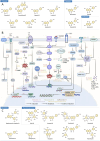Flavonoids as therapeutic agents for epilepsy: unveiling anti-inflammatory and antioxidant pathways for novel treatments
- PMID: 39329119
- PMCID: PMC11424894
- DOI: 10.3389/fphar.2024.1457284
Flavonoids as therapeutic agents for epilepsy: unveiling anti-inflammatory and antioxidant pathways for novel treatments
Abstract
Epilepsy, a chronic neurological disorder affecting millions globally, is often exacerbated by neuroinflammation and oxidative stress. Existing antiepileptic drugs primarily manage symptoms, leaving the disease's progression largely unaddressed. Flavonoids, ubiquitous plant metabolites with potent anti-inflammatory and antioxidant properties, show promise in epilepsy treatment. Unlike conventional therapies, they target multiple pathophysiological processes simultaneously, offering a comprehensive approach to this complex neurological disorder. This review explores the dual role of flavonoids in mitigating neuroinflammation and reducing oxidative stress through various molecular pathways. By inhibiting key inflammatory mediators and pathways such as NF-κB, MAPK, JNK, and JAK, flavonoids offer neuronal protection. They enhance the body's natural antioxidant defenses by modulating enzyme activities, including superoxide dismutase, catalase, and glutathione peroxidase. Moreover, flavonoids influence crucial antioxidant response pathways like PI3K/AKT, Nrf2, JNK, and PKA. Despite their therapeutic promise, the low bioavailability of flavonoids poses a considerable challenge. However, cutting-edge strategies, including nanotechnology and chemical modifications, are underway to improve their bioavailability and therapeutic efficacy. These advancements support the potential of flavonoids as a valuable addition to epilepsy treatment strategies.
Keywords: anti-inflammation; antioxidation; epilepsy; flavonoids; neurological pathways.
Copyright © 2024 Zhang, Hu and Zou.
Conflict of interest statement
The authors declare that the research was conducted in the absence of any commercial or financial relationships that could be construed as a potential conflict of interest.
Figures


Similar articles
-
Nuclear Factor Kappa B: A Nobel Therapeutic Target of FlavonoidsAgainst Parkinson's Disease.Comb Chem High Throughput Screen. 2024;27(14):2062-2077. doi: 10.2174/0113862073295568240105025006. Comb Chem High Throughput Screen. 2024. PMID: 38243959 Review.
-
Icariin ameliorates the cuprizone-induced demyelination associated with antioxidation and anti-inflammation.Inflammopharmacology. 2024 Feb;32(1):809-823. doi: 10.1007/s10787-023-01388-6. Epub 2024 Jan 4. Inflammopharmacology. 2024. PMID: 38177566
-
Phytochemical insights into flavonoids in cancer: Mechanisms, therapeutic potential, and the case of quercetin.Heliyon. 2025 Feb 13;11(4):e42682. doi: 10.1016/j.heliyon.2025.e42682. eCollection 2025 Feb 28. Heliyon. 2025. PMID: 40084006 Free PMC article. Review.
-
Unveiling Nature's potential: Promising natural compounds in Parkinson's disease management.Parkinsonism Relat Disord. 2023 Oct;115:105799. doi: 10.1016/j.parkreldis.2023.105799. Epub 2023 Aug 10. Parkinsonism Relat Disord. 2023. PMID: 37633805 Review.
-
Beneficial effects of natural flavonoids on neuroinflammation.Front Immunol. 2022 Oct 24;13:1006434. doi: 10.3389/fimmu.2022.1006434. eCollection 2022. Front Immunol. 2022. PMID: 36353622 Free PMC article. Review.
Cited by
-
Female germline stem cells: recent advances, opportunities, and challenges to overcome.Cell Regen. 2025 Aug 12;14(1):34. doi: 10.1186/s13619-025-00256-8. Cell Regen. 2025. PMID: 40794227 Free PMC article. Review.
-
Therapeutic Efficacy of Lavandula dentata's Oil and Ethanol Extract in Regulation of the Neuroinflammation, Histopathological Alterations, Oxidative Stress, and Restoring Balance Treg Cells Expressing FoxP3+ in a Rat Model of Epilepsy.Pharmaceuticals (Basel). 2024 Dec 31;18(1):35. doi: 10.3390/ph18010035. Pharmaceuticals (Basel). 2024. PMID: 39861097 Free PMC article.
-
Oxidative Stress in Benign Prostatic Hyperplasia: Mechanisms, Clinical Relevance and Therapeutic Perspectives.Diseases. 2025 Feb 11;13(2):53. doi: 10.3390/diseases13020053. Diseases. 2025. PMID: 39997060 Free PMC article. Review.
-
Rhoifolin as a potential anxiolytic drug for the effects of nicotine withdrawal: beneficial effects on behavior, neuroinflammation, and oxidative stress.Metab Brain Dis. 2025 May 20;40(5):208. doi: 10.1007/s11011-025-01627-5. Metab Brain Dis. 2025. PMID: 40392377
-
Unraveling potent Glycyrrhiza glabra flavonoids as AKT1 inhibitors using network pharmacology and machine learning-assisted QSAR.Mol Divers. 2025 Aug;29(4):3607-3635. doi: 10.1007/s11030-025-11210-w. Epub 2025 May 8. Mol Divers. 2025. PMID: 40335842
References
-
- Abd El-Aal S. A., El-Abhar H. S., Abulfadl Y. S. (2022). Morin offsets PTZ-induced neuronal degeneration and cognitive decrements in rats: the modulation of TNF-α/TNFR-1/RIPK1,3/MLKL/PGAM5/Drp-1, IL-6/JAK2/STAT3/GFAP and Keap-1/Nrf-2/HO-1 trajectories. Eur. J. Pharmacol. 931, 175213. 10.1016/j.ejphar.2022.175213 - DOI - PubMed
-
- Ahmad N., Ahmad R., Alrasheed R. A., Almatar H. M. A., Al-Ramadan A. S., Amir M., et al. (2020). Quantification and evaluations of catechin hydrate polymeric nanoparticles used in brain targeting for the treatment of epilepsy. Pharmaceutics 12 (3), 203. 10.3390/pharmaceutics12030203 - DOI - PMC - PubMed
Publication types
LinkOut - more resources
Full Text Sources
Research Materials

